Taxation Law 77938: Evaluating Income Tax for Jill (UTS Report)
VerifiedAdded on 2023/06/04
|6
|1853
|112
Report
AI Summary
This report provides a detailed analysis of Jill's income tax consequences for the 2017/2018 income year, addressing whether various amounts and benefits she acquired are taxable and if any expenditures she incurred are deductible for Australian income tax purposes. The report considers her salary, bonus, awards, business income from sewing curtains and selling books, interest paid on loans, rental property income, and insurance payouts. It applies relevant taxation laws and principles to determine the tax implications of each transaction, including considerations for goods and services tax (GST), capital gains, and allowable deductions. The report concludes with advice for Jill on how to calculate her tax liability, emphasizing the importance of including all business activities and claiming eligible expenses to minimize her taxable income, while also addressing the capital loss related to the destroyed rental property and the use of insurance compensation to settle the loan.
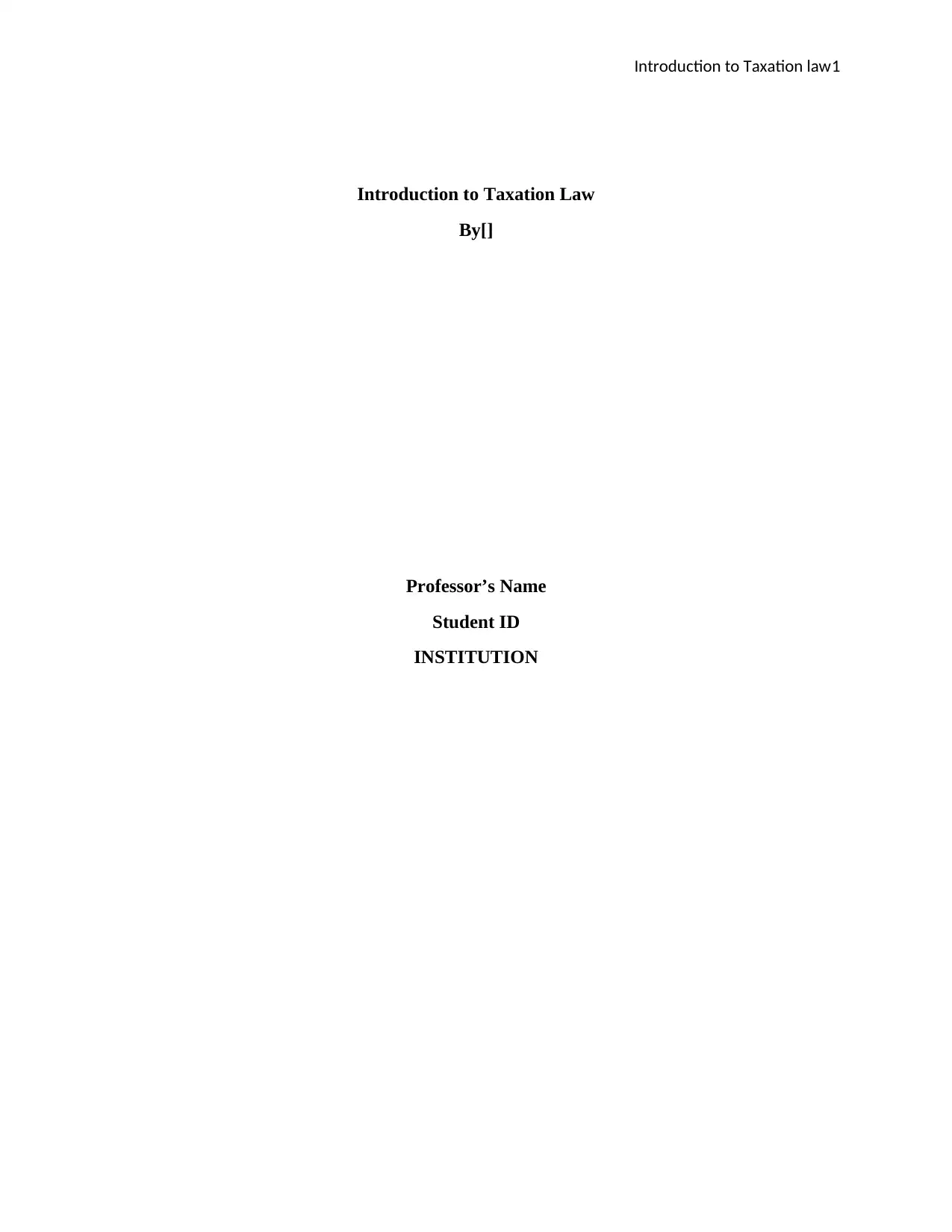
Introduction to Taxation law1
Introduction to Taxation Law
By[]
Professor’s Name
Student ID
INSTITUTION
Introduction to Taxation Law
By[]
Professor’s Name
Student ID
INSTITUTION
Secure Best Marks with AI Grader
Need help grading? Try our AI Grader for instant feedback on your assignments.
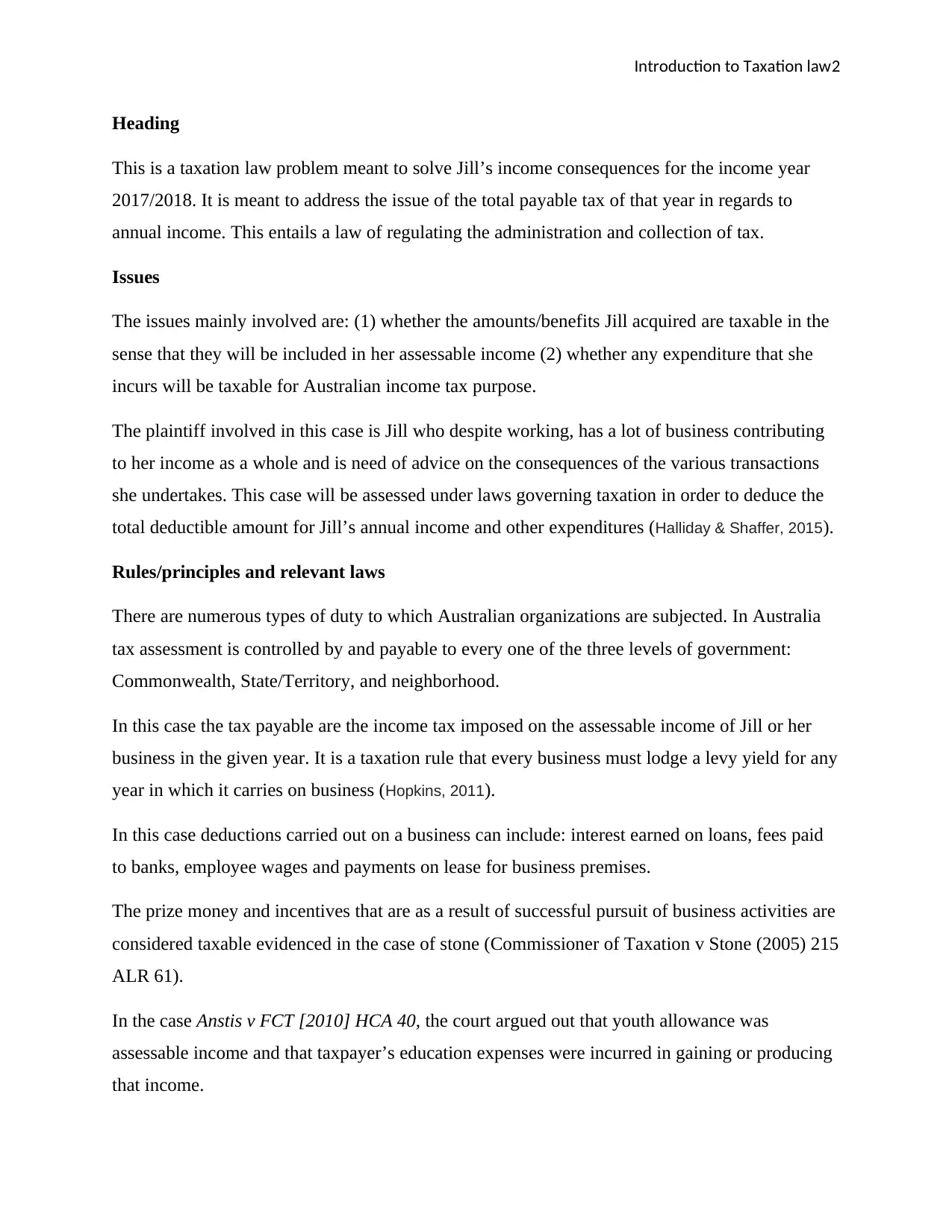
Introduction to Taxation law2
Heading
This is a taxation law problem meant to solve Jill’s income consequences for the income year
2017/2018. It is meant to address the issue of the total payable tax of that year in regards to
annual income. This entails a law of regulating the administration and collection of tax.
Issues
The issues mainly involved are: (1) whether the amounts/benefits Jill acquired are taxable in the
sense that they will be included in her assessable income (2) whether any expenditure that she
incurs will be taxable for Australian income tax purpose.
The plaintiff involved in this case is Jill who despite working, has a lot of business contributing
to her income as a whole and is need of advice on the consequences of the various transactions
she undertakes. This case will be assessed under laws governing taxation in order to deduce the
total deductible amount for Jill’s annual income and other expenditures (Halliday & Shaffer, 2015).
Rules/principles and relevant laws
There are numerous types of duty to which Australian organizations are subjected. In Australia
tax assessment is controlled by and payable to every one of the three levels of government:
Commonwealth, State/Territory, and neighborhood.
In this case the tax payable are the income tax imposed on the assessable income of Jill or her
business in the given year. It is a taxation rule that every business must lodge a levy yield for any
year in which it carries on business (Hopkins, 2011).
In this case deductions carried out on a business can include: interest earned on loans, fees paid
to banks, employee wages and payments on lease for business premises.
The prize money and incentives that are as a result of successful pursuit of business activities are
considered taxable evidenced in the case of stone (Commissioner of Taxation v Stone (2005) 215
ALR 61).
In the case Anstis v FCT [2010] HCA 40, the court argued out that youth allowance was
assessable income and that taxpayer’s education expenses were incurred in gaining or producing
that income.
Heading
This is a taxation law problem meant to solve Jill’s income consequences for the income year
2017/2018. It is meant to address the issue of the total payable tax of that year in regards to
annual income. This entails a law of regulating the administration and collection of tax.
Issues
The issues mainly involved are: (1) whether the amounts/benefits Jill acquired are taxable in the
sense that they will be included in her assessable income (2) whether any expenditure that she
incurs will be taxable for Australian income tax purpose.
The plaintiff involved in this case is Jill who despite working, has a lot of business contributing
to her income as a whole and is need of advice on the consequences of the various transactions
she undertakes. This case will be assessed under laws governing taxation in order to deduce the
total deductible amount for Jill’s annual income and other expenditures (Halliday & Shaffer, 2015).
Rules/principles and relevant laws
There are numerous types of duty to which Australian organizations are subjected. In Australia
tax assessment is controlled by and payable to every one of the three levels of government:
Commonwealth, State/Territory, and neighborhood.
In this case the tax payable are the income tax imposed on the assessable income of Jill or her
business in the given year. It is a taxation rule that every business must lodge a levy yield for any
year in which it carries on business (Hopkins, 2011).
In this case deductions carried out on a business can include: interest earned on loans, fees paid
to banks, employee wages and payments on lease for business premises.
The prize money and incentives that are as a result of successful pursuit of business activities are
considered taxable evidenced in the case of stone (Commissioner of Taxation v Stone (2005) 215
ALR 61).
In the case Anstis v FCT [2010] HCA 40, the court argued out that youth allowance was
assessable income and that taxpayer’s education expenses were incurred in gaining or producing
that income.
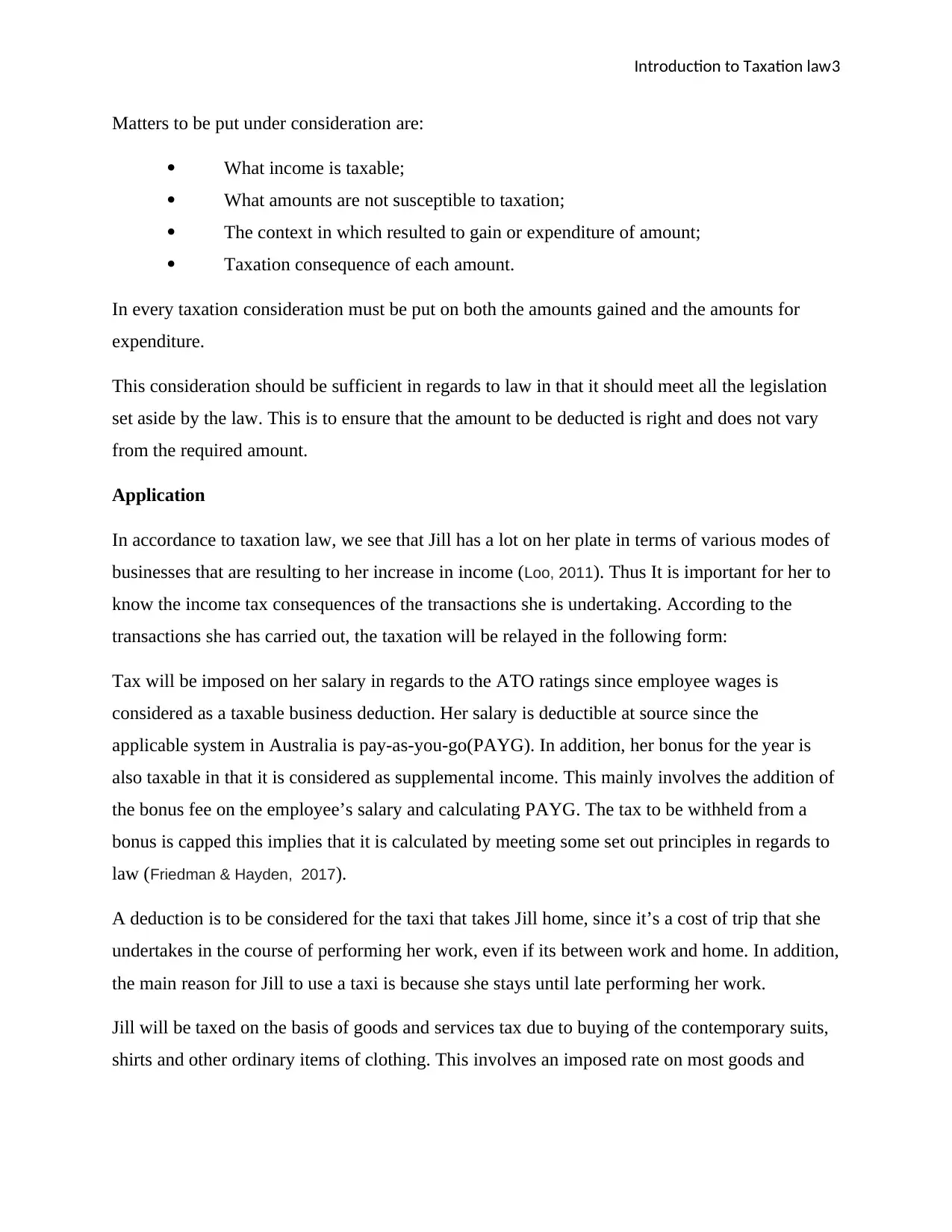
Introduction to Taxation law3
Matters to be put under consideration are:
What income is taxable;
What amounts are not susceptible to taxation;
The context in which resulted to gain or expenditure of amount;
Taxation consequence of each amount.
In every taxation consideration must be put on both the amounts gained and the amounts for
expenditure.
This consideration should be sufficient in regards to law in that it should meet all the legislation
set aside by the law. This is to ensure that the amount to be deducted is right and does not vary
from the required amount.
Application
In accordance to taxation law, we see that Jill has a lot on her plate in terms of various modes of
businesses that are resulting to her increase in income (Loo, 2011). Thus It is important for her to
know the income tax consequences of the transactions she is undertaking. According to the
transactions she has carried out, the taxation will be relayed in the following form:
Tax will be imposed on her salary in regards to the ATO ratings since employee wages is
considered as a taxable business deduction. Her salary is deductible at source since the
applicable system in Australia is pay-as-you-go(PAYG). In addition, her bonus for the year is
also taxable in that it is considered as supplemental income. This mainly involves the addition of
the bonus fee on the employee’s salary and calculating PAYG. The tax to be withheld from a
bonus is capped this implies that it is calculated by meeting some set out principles in regards to
law (Friedman & Hayden, 2017).
A deduction is to be considered for the taxi that takes Jill home, since it’s a cost of trip that she
undertakes in the course of performing her work, even if its between work and home. In addition,
the main reason for Jill to use a taxi is because she stays until late performing her work.
Jill will be taxed on the basis of goods and services tax due to buying of the contemporary suits,
shirts and other ordinary items of clothing. This involves an imposed rate on most goods and
Matters to be put under consideration are:
What income is taxable;
What amounts are not susceptible to taxation;
The context in which resulted to gain or expenditure of amount;
Taxation consequence of each amount.
In every taxation consideration must be put on both the amounts gained and the amounts for
expenditure.
This consideration should be sufficient in regards to law in that it should meet all the legislation
set aside by the law. This is to ensure that the amount to be deducted is right and does not vary
from the required amount.
Application
In accordance to taxation law, we see that Jill has a lot on her plate in terms of various modes of
businesses that are resulting to her increase in income (Loo, 2011). Thus It is important for her to
know the income tax consequences of the transactions she is undertaking. According to the
transactions she has carried out, the taxation will be relayed in the following form:
Tax will be imposed on her salary in regards to the ATO ratings since employee wages is
considered as a taxable business deduction. Her salary is deductible at source since the
applicable system in Australia is pay-as-you-go(PAYG). In addition, her bonus for the year is
also taxable in that it is considered as supplemental income. This mainly involves the addition of
the bonus fee on the employee’s salary and calculating PAYG. The tax to be withheld from a
bonus is capped this implies that it is calculated by meeting some set out principles in regards to
law (Friedman & Hayden, 2017).
A deduction is to be considered for the taxi that takes Jill home, since it’s a cost of trip that she
undertakes in the course of performing her work, even if its between work and home. In addition,
the main reason for Jill to use a taxi is because she stays until late performing her work.
Jill will be taxed on the basis of goods and services tax due to buying of the contemporary suits,
shirts and other ordinary items of clothing. This involves an imposed rate on most goods and
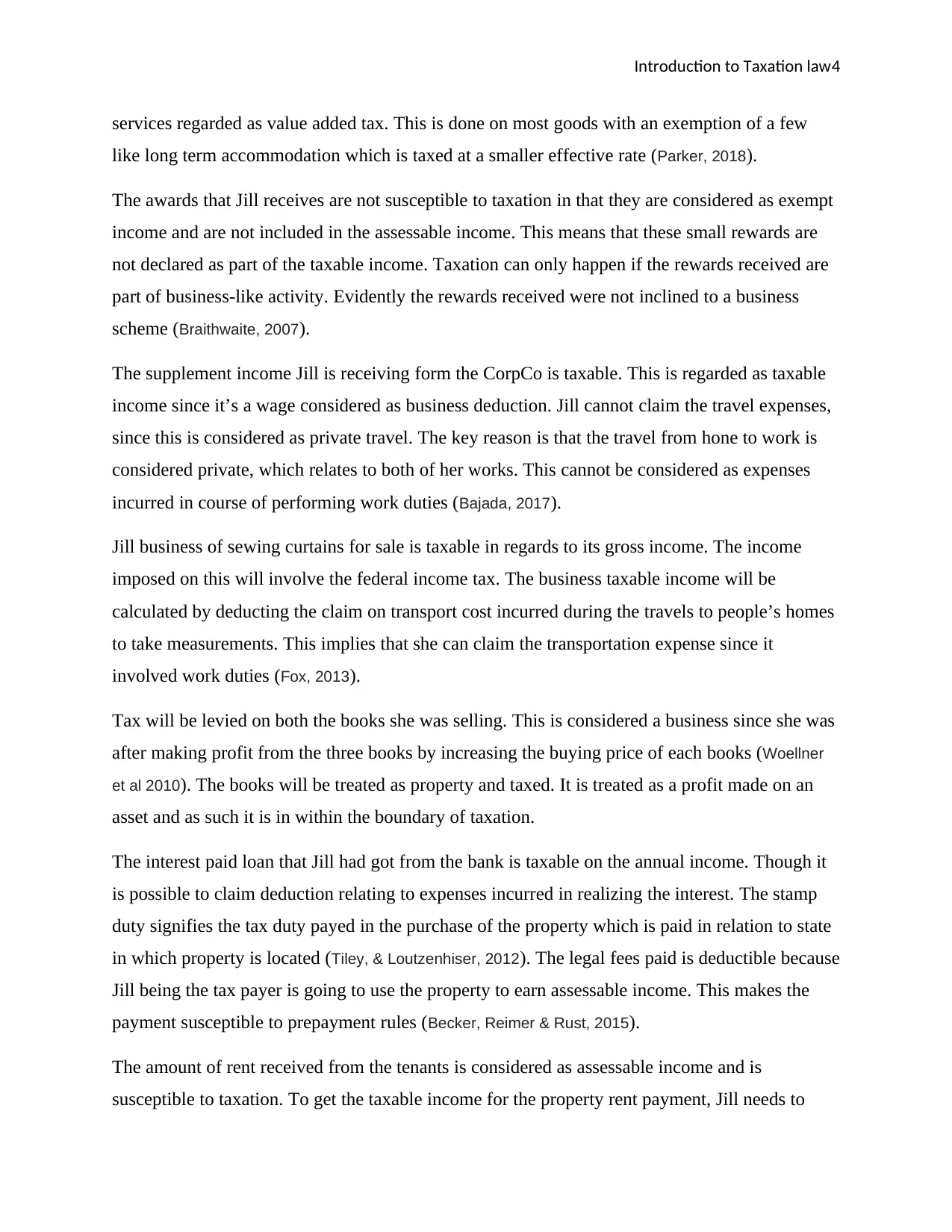
Introduction to Taxation law4
services regarded as value added tax. This is done on most goods with an exemption of a few
like long term accommodation which is taxed at a smaller effective rate (Parker, 2018).
The awards that Jill receives are not susceptible to taxation in that they are considered as exempt
income and are not included in the assessable income. This means that these small rewards are
not declared as part of the taxable income. Taxation can only happen if the rewards received are
part of business-like activity. Evidently the rewards received were not inclined to a business
scheme (Braithwaite, 2007).
The supplement income Jill is receiving form the CorpCo is taxable. This is regarded as taxable
income since it’s a wage considered as business deduction. Jill cannot claim the travel expenses,
since this is considered as private travel. The key reason is that the travel from hone to work is
considered private, which relates to both of her works. This cannot be considered as expenses
incurred in course of performing work duties (Bajada, 2017).
Jill business of sewing curtains for sale is taxable in regards to its gross income. The income
imposed on this will involve the federal income tax. The business taxable income will be
calculated by deducting the claim on transport cost incurred during the travels to people’s homes
to take measurements. This implies that she can claim the transportation expense since it
involved work duties (Fox, 2013).
Tax will be levied on both the books she was selling. This is considered a business since she was
after making profit from the three books by increasing the buying price of each books (Woellner
et al 2010). The books will be treated as property and taxed. It is treated as a profit made on an
asset and as such it is in within the boundary of taxation.
The interest paid loan that Jill had got from the bank is taxable on the annual income. Though it
is possible to claim deduction relating to expenses incurred in realizing the interest. The stamp
duty signifies the tax duty payed in the purchase of the property which is paid in relation to state
in which property is located (Tiley, & Loutzenhiser, 2012). The legal fees paid is deductible because
Jill being the tax payer is going to use the property to earn assessable income. This makes the
payment susceptible to prepayment rules (Becker, Reimer & Rust, 2015).
The amount of rent received from the tenants is considered as assessable income and is
susceptible to taxation. To get the taxable income for the property rent payment, Jill needs to
services regarded as value added tax. This is done on most goods with an exemption of a few
like long term accommodation which is taxed at a smaller effective rate (Parker, 2018).
The awards that Jill receives are not susceptible to taxation in that they are considered as exempt
income and are not included in the assessable income. This means that these small rewards are
not declared as part of the taxable income. Taxation can only happen if the rewards received are
part of business-like activity. Evidently the rewards received were not inclined to a business
scheme (Braithwaite, 2007).
The supplement income Jill is receiving form the CorpCo is taxable. This is regarded as taxable
income since it’s a wage considered as business deduction. Jill cannot claim the travel expenses,
since this is considered as private travel. The key reason is that the travel from hone to work is
considered private, which relates to both of her works. This cannot be considered as expenses
incurred in course of performing work duties (Bajada, 2017).
Jill business of sewing curtains for sale is taxable in regards to its gross income. The income
imposed on this will involve the federal income tax. The business taxable income will be
calculated by deducting the claim on transport cost incurred during the travels to people’s homes
to take measurements. This implies that she can claim the transportation expense since it
involved work duties (Fox, 2013).
Tax will be levied on both the books she was selling. This is considered a business since she was
after making profit from the three books by increasing the buying price of each books (Woellner
et al 2010). The books will be treated as property and taxed. It is treated as a profit made on an
asset and as such it is in within the boundary of taxation.
The interest paid loan that Jill had got from the bank is taxable on the annual income. Though it
is possible to claim deduction relating to expenses incurred in realizing the interest. The stamp
duty signifies the tax duty payed in the purchase of the property which is paid in relation to state
in which property is located (Tiley, & Loutzenhiser, 2012). The legal fees paid is deductible because
Jill being the tax payer is going to use the property to earn assessable income. This makes the
payment susceptible to prepayment rules (Becker, Reimer & Rust, 2015).
The amount of rent received from the tenants is considered as assessable income and is
susceptible to taxation. To get the taxable income for the property rent payment, Jill needs to
Secure Best Marks with AI Grader
Need help grading? Try our AI Grader for instant feedback on your assignments.
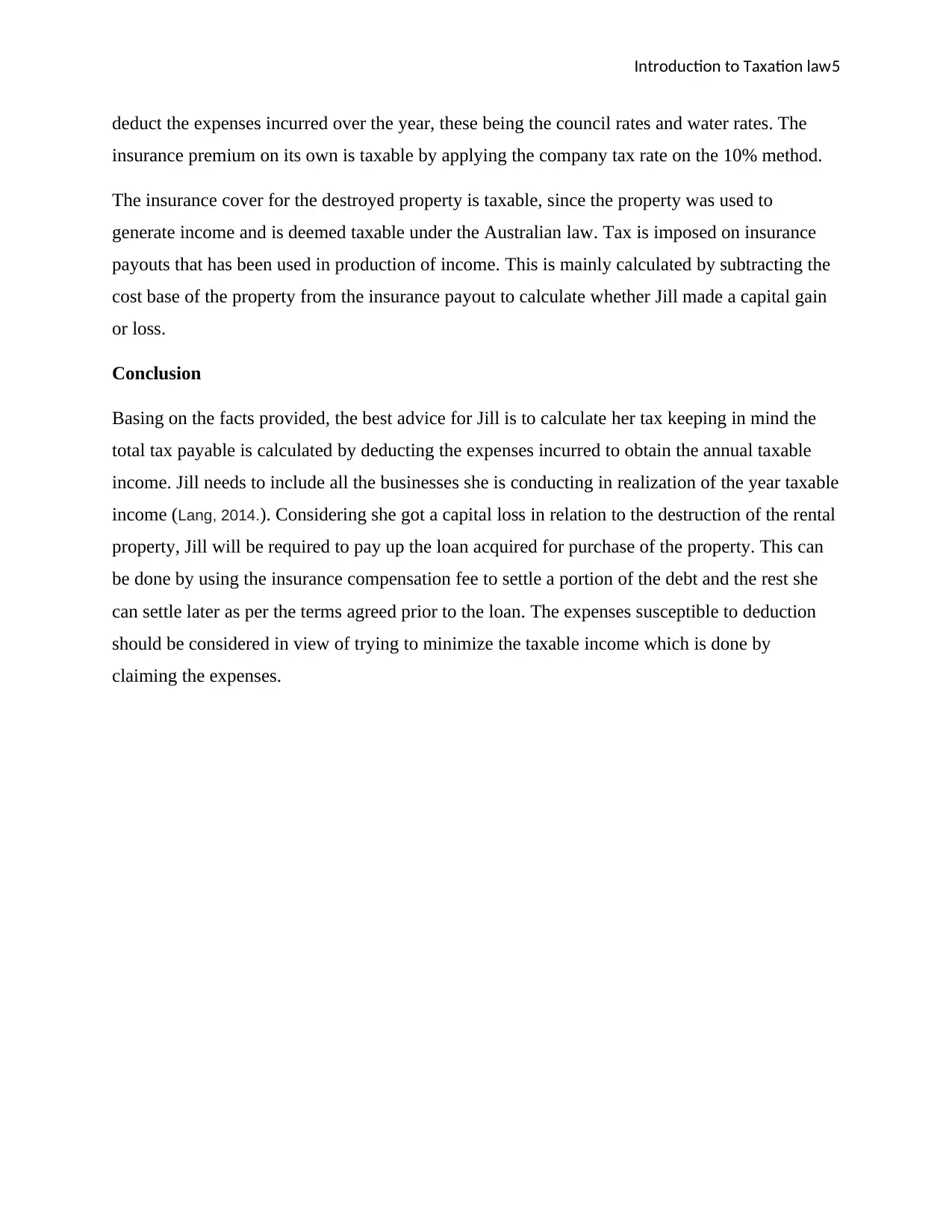
Introduction to Taxation law5
deduct the expenses incurred over the year, these being the council rates and water rates. The
insurance premium on its own is taxable by applying the company tax rate on the 10% method.
The insurance cover for the destroyed property is taxable, since the property was used to
generate income and is deemed taxable under the Australian law. Tax is imposed on insurance
payouts that has been used in production of income. This is mainly calculated by subtracting the
cost base of the property from the insurance payout to calculate whether Jill made a capital gain
or loss.
Conclusion
Basing on the facts provided, the best advice for Jill is to calculate her tax keeping in mind the
total tax payable is calculated by deducting the expenses incurred to obtain the annual taxable
income. Jill needs to include all the businesses she is conducting in realization of the year taxable
income (Lang, 2014.). Considering she got a capital loss in relation to the destruction of the rental
property, Jill will be required to pay up the loan acquired for purchase of the property. This can
be done by using the insurance compensation fee to settle a portion of the debt and the rest she
can settle later as per the terms agreed prior to the loan. The expenses susceptible to deduction
should be considered in view of trying to minimize the taxable income which is done by
claiming the expenses.
deduct the expenses incurred over the year, these being the council rates and water rates. The
insurance premium on its own is taxable by applying the company tax rate on the 10% method.
The insurance cover for the destroyed property is taxable, since the property was used to
generate income and is deemed taxable under the Australian law. Tax is imposed on insurance
payouts that has been used in production of income. This is mainly calculated by subtracting the
cost base of the property from the insurance payout to calculate whether Jill made a capital gain
or loss.
Conclusion
Basing on the facts provided, the best advice for Jill is to calculate her tax keeping in mind the
total tax payable is calculated by deducting the expenses incurred to obtain the annual taxable
income. Jill needs to include all the businesses she is conducting in realization of the year taxable
income (Lang, 2014.). Considering she got a capital loss in relation to the destruction of the rental
property, Jill will be required to pay up the loan acquired for purchase of the property. This can
be done by using the insurance compensation fee to settle a portion of the debt and the rest she
can settle later as per the terms agreed prior to the loan. The expenses susceptible to deduction
should be considered in view of trying to minimize the taxable income which is done by
claiming the expenses.
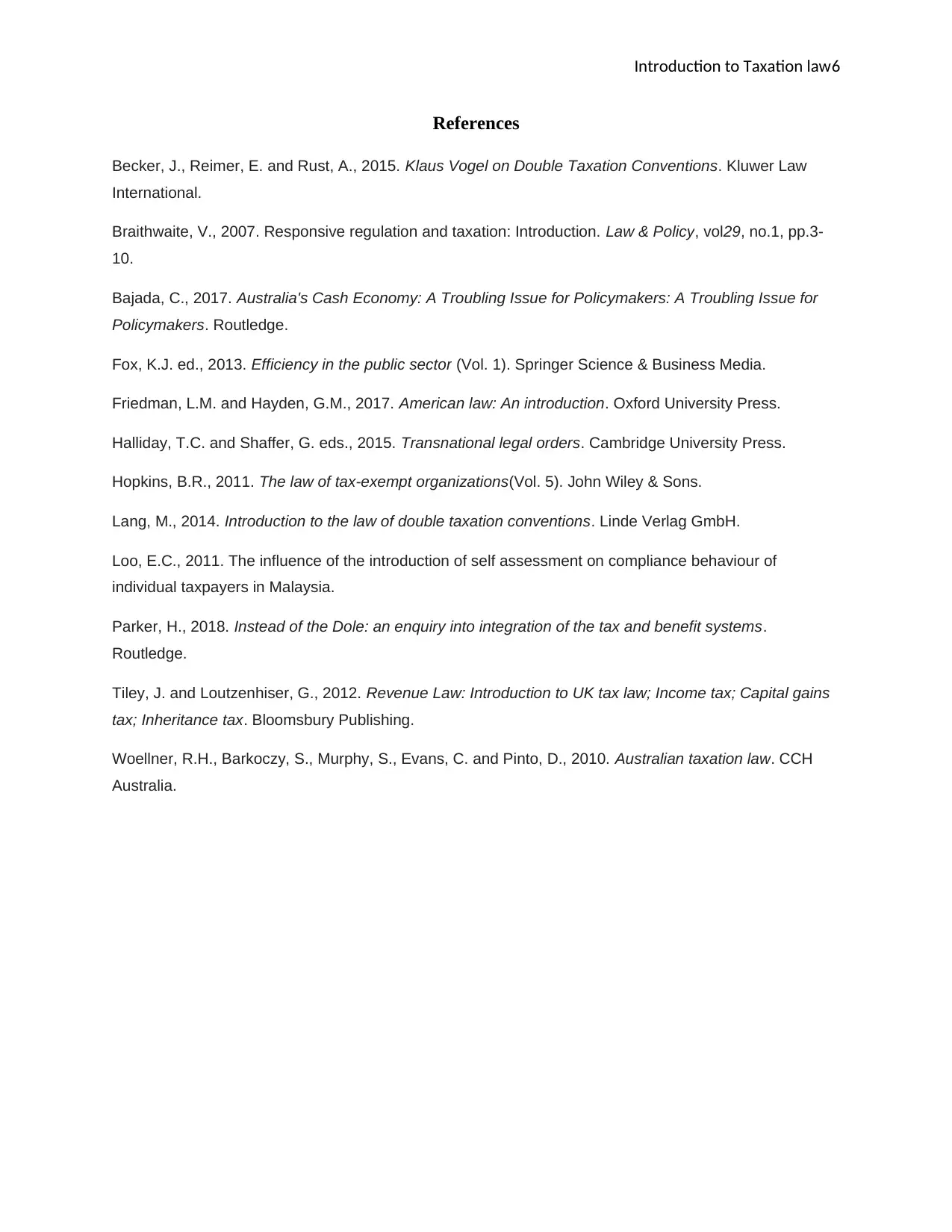
Introduction to Taxation law6
References
Becker, J., Reimer, E. and Rust, A., 2015. Klaus Vogel on Double Taxation Conventions. Kluwer Law
International.
Braithwaite, V., 2007. Responsive regulation and taxation: Introduction. Law & Policy, vol29, no.1, pp.3-
10.
Bajada, C., 2017. Australia's Cash Economy: A Troubling Issue for Policymakers: A Troubling Issue for
Policymakers. Routledge.
Fox, K.J. ed., 2013. Efficiency in the public sector (Vol. 1). Springer Science & Business Media.
Friedman, L.M. and Hayden, G.M., 2017. American law: An introduction. Oxford University Press.
Halliday, T.C. and Shaffer, G. eds., 2015. Transnational legal orders. Cambridge University Press.
Hopkins, B.R., 2011. The law of tax-exempt organizations(Vol. 5). John Wiley & Sons.
Lang, M., 2014. Introduction to the law of double taxation conventions. Linde Verlag GmbH.
Loo, E.C., 2011. The influence of the introduction of self assessment on compliance behaviour of
individual taxpayers in Malaysia.
Parker, H., 2018. Instead of the Dole: an enquiry into integration of the tax and benefit systems.
Routledge.
Tiley, J. and Loutzenhiser, G., 2012. Revenue Law: Introduction to UK tax law; Income tax; Capital gains
tax; Inheritance tax. Bloomsbury Publishing.
Woellner, R.H., Barkoczy, S., Murphy, S., Evans, C. and Pinto, D., 2010. Australian taxation law. CCH
Australia.
References
Becker, J., Reimer, E. and Rust, A., 2015. Klaus Vogel on Double Taxation Conventions. Kluwer Law
International.
Braithwaite, V., 2007. Responsive regulation and taxation: Introduction. Law & Policy, vol29, no.1, pp.3-
10.
Bajada, C., 2017. Australia's Cash Economy: A Troubling Issue for Policymakers: A Troubling Issue for
Policymakers. Routledge.
Fox, K.J. ed., 2013. Efficiency in the public sector (Vol. 1). Springer Science & Business Media.
Friedman, L.M. and Hayden, G.M., 2017. American law: An introduction. Oxford University Press.
Halliday, T.C. and Shaffer, G. eds., 2015. Transnational legal orders. Cambridge University Press.
Hopkins, B.R., 2011. The law of tax-exempt organizations(Vol. 5). John Wiley & Sons.
Lang, M., 2014. Introduction to the law of double taxation conventions. Linde Verlag GmbH.
Loo, E.C., 2011. The influence of the introduction of self assessment on compliance behaviour of
individual taxpayers in Malaysia.
Parker, H., 2018. Instead of the Dole: an enquiry into integration of the tax and benefit systems.
Routledge.
Tiley, J. and Loutzenhiser, G., 2012. Revenue Law: Introduction to UK tax law; Income tax; Capital gains
tax; Inheritance tax. Bloomsbury Publishing.
Woellner, R.H., Barkoczy, S., Murphy, S., Evans, C. and Pinto, D., 2010. Australian taxation law. CCH
Australia.
1 out of 6
Related Documents
Your All-in-One AI-Powered Toolkit for Academic Success.
+13062052269
info@desklib.com
Available 24*7 on WhatsApp / Email
![[object Object]](/_next/static/media/star-bottom.7253800d.svg)
Unlock your academic potential
© 2024 | Zucol Services PVT LTD | All rights reserved.





